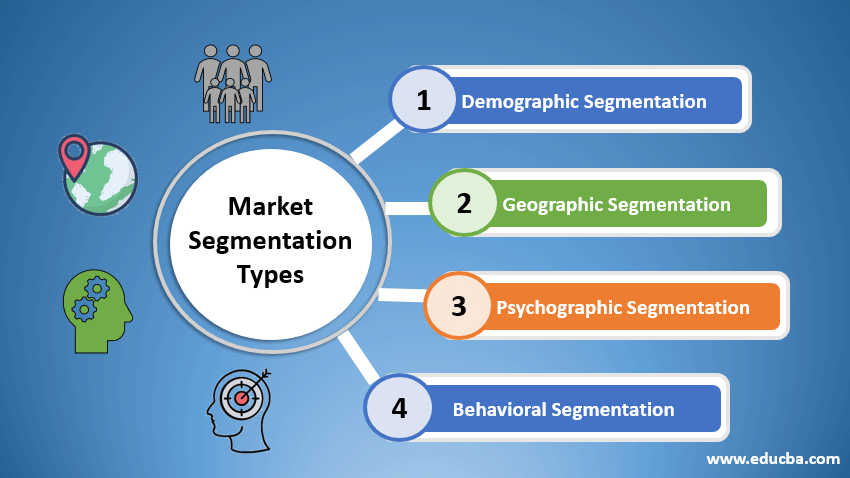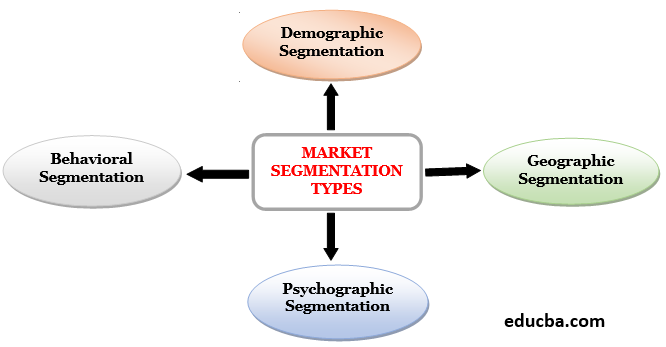Introduction to Market Segmentation Types
As humans tend to differ in their attitudes, requirements, nature, buying behavior’s and lifestyle, market segmentation is a tool that effectively defines and segregates consumers with similar attributes and preferences into smaller groups or segments. It enables us to devise segment-specific strategies and policies to attain results in an efficient and cost-effective way. Thus, Market Segmentation can be defined as a methodology that companies use to segregate targeted consumer markets into smaller units or segments, similar in preferences and attributes, to streamline the promotional, marketing, and sales strategies to attain required results. In this article, we will see in-depth the different types of market segmentation.
Types of Market Segmentation
The four key types of Market Segmentation are illustrated below:
1. Demographic Segmentation
In this type, the consumer market is segregated based on demographic elements such as qualification, salary, gender, marital status, nature of work, age, no of family members, gender, nationality, race, religion, and other factors. It is one of the widely used segmentation tools across most of the industrial sectors, and any information can be easily accessed through common data collection techniques. Therefore, it enables us to separate unspecific customer base in a feasible and cost-effective way. Also, combining it with other segmentation tools further narrows down the consumer base to obtain more relevant markets.
- Example 1: The popular cereal brand, ‘Kellogg’s offers age-specific cereal varieties targeted at kids and mature groups.
- Example 2: Many deodorant companies offer gender-specific aromas, specifically meant for ‘Men’ & ‘Women’.
2. Geographic Segmentation
As the name suggests, this segmentation type is targeted towards a specific set of consumer market confined to the territorial limitations or geographical areas. Consumer preferences and demands vary according to their regional habitats, due to several factors, such as climatic conditions, population, ethnicity, religious beliefs, culture, language and type of area (urban/rural).
Such segmentation is beneficial when consumer localities are the key determiners of buying tendencies. Because customers belonging to different locations have varied requirements based on geographical conditions. Therefore, geographical segmentation enables the brands to focus their marketing and promotional efforts in alignment with the customer requirements. Also, allowing businesses with insights and ways for expansion.
- Example 1: Considering the religious sentiments, Beef is banned in India. Thus, ‘McDonalds India’ does not sell beef-based edibles in the Indian continent. While ‘McDonalds US’ sells beef-based edibles freely across its American restaurant chains.
- Example 2: ‘LG Electronics’ promotes and advertises for its ‘Heaters’ in colder regions and for ‘Air conditioners’ in warmer regions. Thus, based on the climatic conditions, the same brand promotes different products targeted towards specific customer segments.
3. Psychographic Segmentation
Psychographic segmentation is quite subjective in its approach and segregates the markets based on customer attitudes and likings. The factors relevant to this segment are a bit hard to nail down, considering its qualitative nature. Unlike the demographic and geographic segments, it is not data-centered and is difficult to interpret the psychological perceptions of consumers. Psychological segmentation is driven by intangible factors such as customer traits, attitudes, likings, value systems, beliefs, way of life, motivational drive, viewpoints, and other such factors.
Thus, extensive research tools such as survey questionnaires, focus group interviews, case study methods, and consumer interviews are used to retrieve market information. Psychological segmentation requires the companies to understand the mindset and intrinsic attributes of the consumers, based on the variables such as, ‘O’ (Opinions), ‘A’ (Activities) and ‘I’ (Interests), so as to design effective promotional and advertising strategies.
- Example 1: Fitness/Exercise markets target health and fitness-conscious consumers while segregating the consumer base.
- Example 2: ‘Zara stores’ also have segmented their markets based on consumer lifestyles. These stores target customers willing to buy trendy and expensive designer clothes.
4. Behavioral Segmentation
The thin line between ‘Psychographic’ and ‘Behavioral’ segmentation is the ‘former’ focus on ‘who’ a customer is and the latter understands ‘how’ a customer behaves or acts. The factors influencing this segmentation type are buying and spending tendencies of the customers such as buying frequency, brand loyalty, consumption rate and interactions with the brand.
Behavioral Segmentation is segregated based on consumer knowledge and experience with the product, as it influences the decision of the consumers to buy a certain product. Thus, allowing to identify consumers that are aware or unaware of the product, previous consumers, prospective consumers, present consumers or first-time consumers.
Based on the brand interactions, customers are classified as ‘brand-loyal’, ‘brand-neutral’ or ‘rival-loyal’. In such type of segmentation, consumer feedback forums, review portals or records from third parties serve as useful tools to extract market information. It is a stepping stone towards the effective identification of market segments. It enables the companies to market and promotes in personalized/customized ways, due to increased awareness about buyer habits and tendencies.
- Example 1: ‘Sensodyne’ toothpaste brand is specifically targeted at consumers with sensitive teeth. While brands such as ‘Colgate’ and ‘Pepsodent’ are specifically meant for teeth whitening and prevention of tooth decay.
- Example 2: In the smartphone market, ‘Blackberry’ was launched specifically targeting the business population and the promotional strategy gave it exclusivity over other smart-phones. ‘Apple’ was launched for premium consumers, looking for uniqueness.
Conclusion
Having discussed the four key types of Market Segments, it’s importance cannot be undermined. Market Segments help to narrow down the markets effectively and is an essential tool to understand the demands and requirements of the consumers. It not only helps in segregating markets but also enables to design effective promotional campaigns specific to the identified segments.
It is a tool designed to attain maximum results through limited marketing investments, by effectively segregating markets based on certain attributes or elements. It allows the marketing professionals to save on time and money, by enabling them to focus on consumer-relevant markets.
So before launching a product, it is paramount to identify user segments and promote them relevantly. Without proper market segmentation, the product cannot reach the right audience and would be a disaster!
Recommended Articles
This is a guide to Market Segmentation Types. Here we discuss the introduction and 4 key types of market segmentation which include demographic, geographic, psychographic, and behavioral segmentation. You may also look at the following articles to learn more –




